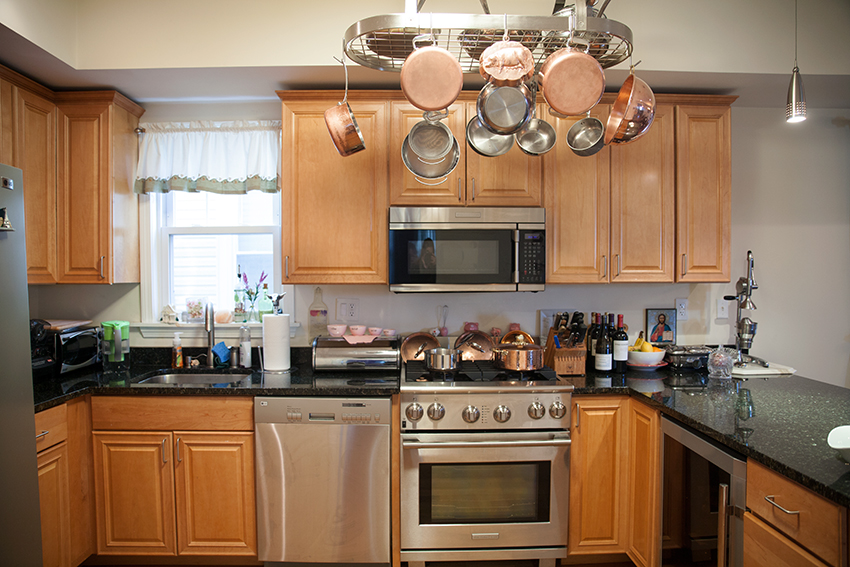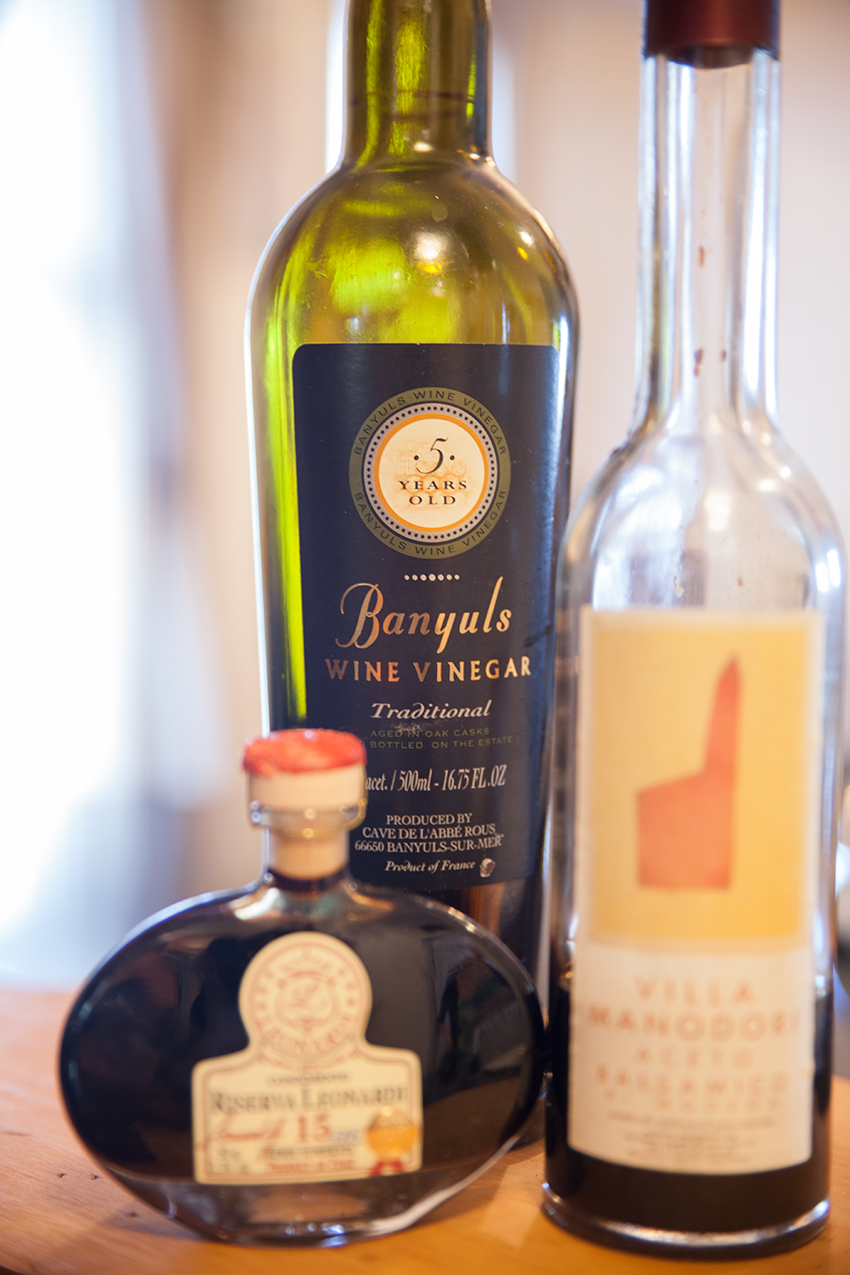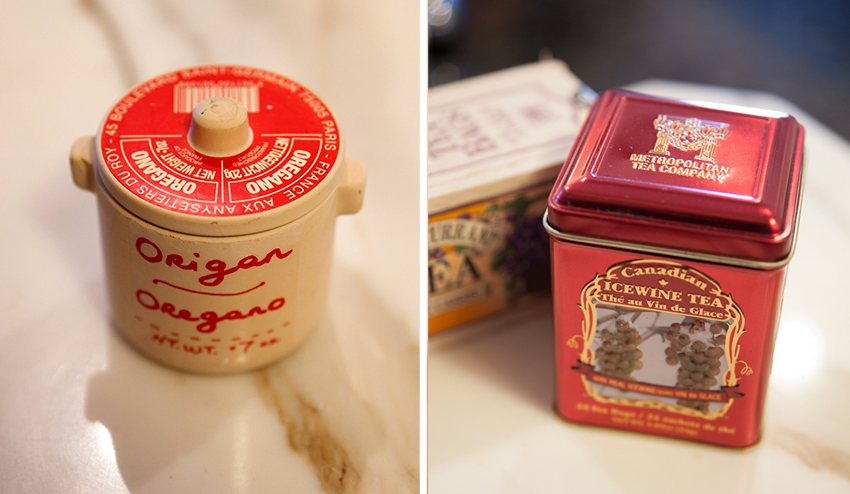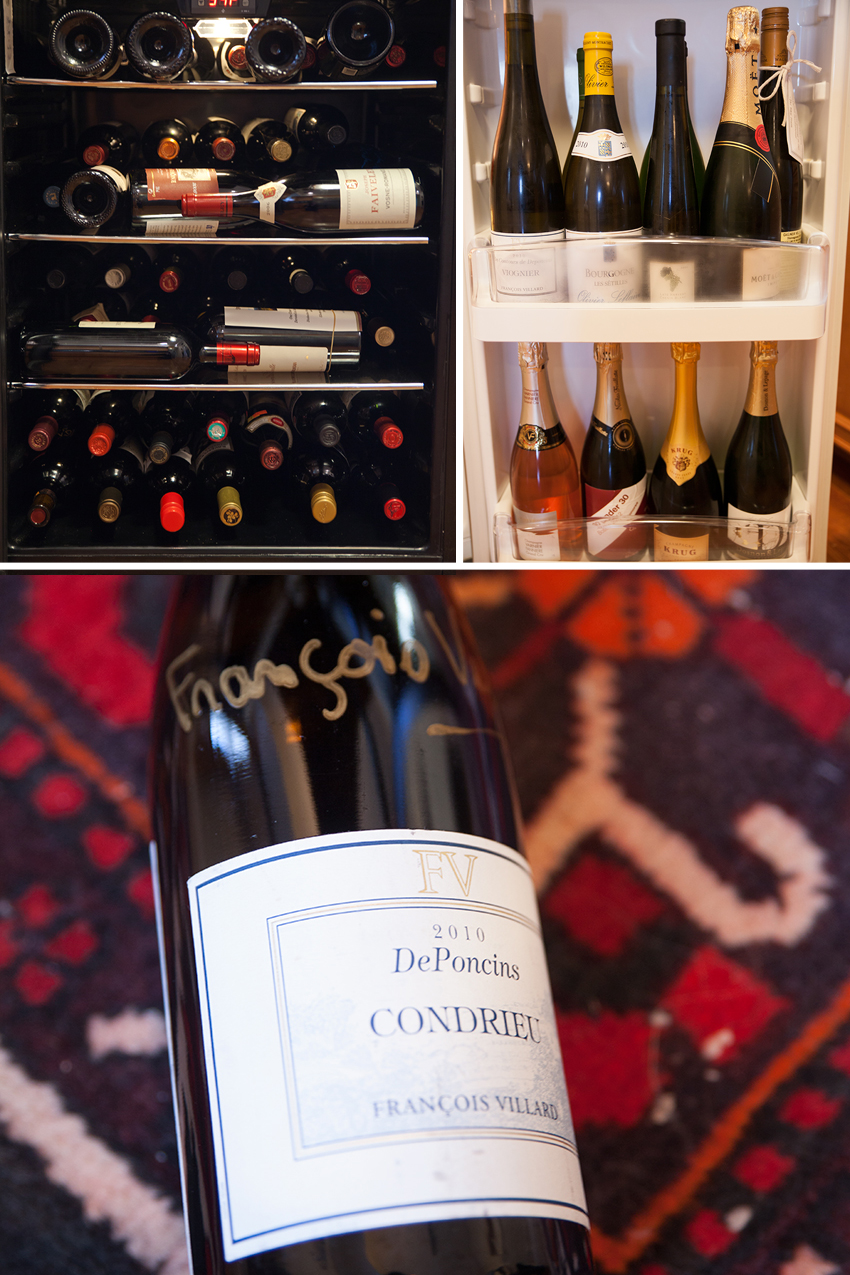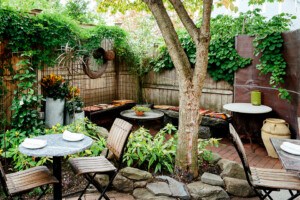The Kitchen Spy: Inside Chris Coombs’s Dorchester Pad
In The Kitchen Spy, we visit local chefs’ home kitchens, and force them to open up their fridge, drawers, and cabinets.
When chef Chris Coombs took over at Dorchester hangout Dbar eight years ago, he didn’t want to live far from his place of work. “I wanted to be fully vested in the neighborhood,” Coombs says. Even though his additional restaurant ventures have taken him to new locales (Deuxave in Back Bay, Boston Chops in the South End), Coombs still lives in the Meeting House Hill home that he purchased in 2006 with his wife, Viktoriya Bulavinova-Coombs, who also works at Deuxave.
Both cook at home (Ed note: since this was shot, Coombs has updated the counters and paint to a splashy deep red), with Bulavinova-Coombs taking charge of breakfast and most dinners, and Coombs tackling the spur-of-the-moment late-night meal as well as the occasional Sunday feast. Both are also avid collectors. Get a peek at said collections—with everything from a baller stash of champagne to an assortment of pig figurines—ahead.
Left: “This is what I like to call the knife graveyard. Once I retire a knife from the kitchen at Deuxave or Boston Chops, I take it to my house,” Coombs says. “The Asian-style cleaver is actually from my time at Blue Ginger—I used it for cutting ginger and lemongrass. The middle knife is from [when I worked at] the Inn at Little Washington. On the left is my culinary school knife, which is worn down as much as it possibly could be. I can’t bring myself to throw them away.”
Right: An old wooden knife block that Coombs’s mother had purchased for him for his birthday before he started working at the Inn at Little Washington in Virginia. “All of the knife blocks everyone else had were stainless steel,” Coombs says. “This became my at home knife block because it wasn’t sanitary to have in the kitchen. That’s almost ten years old now.”
When it comes to cookware, Coombs is all about the copper—particularly if it comes from All Clad or Mauviel. “I love the way they perform,” Coombs says. Left: Recognize the big bowl on the upper right hand corner of the frame? It’s similar to the Mauviel bowls used for tossing and serving frites at Boston Chops. “The ones at Boston Chops are bigger,” Coombs says. “That bowl that I have was the inspiration for the bowls at Boston Chops.” At home, he uses it more for presentation (like serving salads) than its intended uses of whipping egg whites or tempering chocolate.
The fridge contains lots of standard staples (Heinz ketchup, Aunt Jemima syrup, yogurt)…..and a healthy amount of bubbly. “I’ve got some grower Champagne, some Krug, some Meursault,” Coombs says. There’s also some Moet & Chandon, some Dosnon & Lepage, and some Nicolas Feuillatte rose. “I accumulate a lot of wine, but I don’t drink a lot of wine at home unless we have people over, which is very rare….I certainly am a Champagne kind of guy. Champagne and Burgundy are my favorites,” Coombs says.
There may be some fancy bubbly, but Coombs’s can’t-live-without-them items in the fridge are less precious: Mayonnaise, and Coffeemate. “I always put mayo on potatoes, which is an Eastern European thing to do,” he says. “If I’m at home, I’m not going to whip up an aioli at 1 a.m., and Hellman’s seals the deal.” As for the Coffeemate? “That goes in my coffee every morning. I love that stuff.”
Gold-rimmed china, another relic of Coombs’s time at the Inn at Little Washington. “Part of the standard of a five-diamond property was that any plates with visible wear or chips on them could not be used in the dining room,” Coombs says. “Every year when we had our company party, [chef] Patrick [O’Connell] sold the worn or damaged china to the staff for a dollar per plate. Most of the plates I still use today are chipped plates from the Inn at Little Washington.”
Coombs has an enormous library of cookbooks (this photo represents about a quarter of them) and they are all organized around when he acquired them. “These are all at least 10 years old,” he says of this cluster in particular. “Having your shelves organized that way shows you the progression of food. It shows me how I was thinking about food at the time, and what I was reading.” Some of his most beloved books come from Charlie Trotter, Julia Child, Daniel Boulud, Harold McGee, and Michel Guerard. “Michel Guerard basically changed food in the ’70s,” Coombs says. “He created lighter versions of traditional nouvelle cuisine.”
Background: “Banyuls [vinegar] is my favorite vinegar to cook with at home,” Coombs says. “That’s a five-year aged Banyuls [vinegar]. It’s an expensive vinegar, but I absolutely love the acidity. It’s not just a great salad vinegar, but also a great cooking vinegar.” Foreground: Two specialty balsamic vinegars. At left, a 15-year-old variety that was a gift from a chef friend, who brought it back from Italy. “I’ve had that for eight years; I’m waiting for a special time to open it,” Coombs says. At right, Villa Manadori Balsamico. “It’s more of a finishing balsamic,” Coombs says. “It’s delicious, thick, wonderful, and rich. That’s not what you’d cook with, it’s more for dressing a finished salad or tomatoes in the summer.”
Chefs love pig paraphernalia. (Want evidence? See the The Kitchen Spy with Jason Bond, Joshua Lewin, Tony Maws, Carolyn Johnson & Bill Flumerfelt.) But the pig obsession in the Coombs household comes from Viktoriya. “Her nickname in Russia was Hrushka. In Russian, that means little piggy,” Coombs says. As a result, the couple owns a pig cutting board, copper jello mold, cooking timer, bacon press, wall decoration, and more.
Left: A vintage juice press that Coombs scored at a Dorchester yard sale. “I was driving by on Pleasant Street at 30 miles per hour. I saw it out of the corner of my eye, the sunshine was glimmering, and I knew it had to be mine,” Coombs says. In the summertime, he uses it to make lemonade and cocktails. Right: This cow-head-topped paper towel holder was originally supposed to function as an onion ring holder at Boston Chops. “I got this in as a sample, and my business partners were like, ‘This is amazing, but everyone will steal these bullheads,’ which were $50 each.”
Left: Oregano purchased on a trip to France. Right: In the foreground, ice wine tea. “My wife and I are super into tea, and every time we travel, we get tea,” Coombs says. “We were in Banff of Jasper in Alberta, and they had ice wine tea. It’s pretty interesting.” In the background is a box of black currant tea. “That’s a Russian thing. It’s like a summer iced tea…when currants are in season, they do a fresh currant tea. This is the dry version of that,” Coombs says. Typically, the couple’s stash hovers around 50 boxes. “I often have to place embargoes on [Viktoriya’s] tea purchasing because we run out of counter space,” Coombs says.
Top: Although he’s not a huge drinker at home, Coombs has amassed a formidable collection of wine—six or seven hundred bottles, he surmises—kept in multiple Eurocave storage units (some stored in the basement). “Most of the wine that’s out my house is stuff that I am aging for the future,” Coombs says. “I like my Bordeaux to have some age. Whenever there is a good vintage, I buy a couple of cases. Same with Burgundy. When I’m older, I will appreciate having put away some of these great vintages for the future.” Bottom: A bottle of Condrieu signed by winemaker François Villard, following a wine dinner at Deuxave. “We probably have about 20-30 different bottles of wine signed by the winemaker,” Coombs says. “It’s a conversation piece.”
